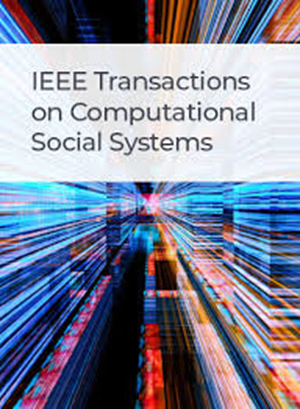Explainable Dual-Branch Combination Network With Key Words Embedding and Position Attention for Sentimental Analytics of Social Media Short Comments
IF 4.5
2区 计算机科学
Q1 COMPUTER SCIENCE, CYBERNETICS
IEEE Transactions on Computational Social Systems
Pub Date : 2025-02-06
DOI:10.1109/TCSS.2025.3532984
引用次数: 0
Abstract
Social media platforms such as Weibo and TikTok have become more influential than traditional media. Sentiment in social media comments reflects users’ attitudes and impacts society, making sentiment analysis (SA) crucial. AI driven models, especially deep-learning models, have achieved excellent results in SA tasks. However, most existing models are not interpretable enough. First, deep learning models have numerous parameters, and their transparency is insufficient. People cannot easily understand how the models extract features from input data and make sentiment judgments. Second, most models lack intuitive explanations. They cannot clearly indicate which words or phrases are key for emotion prediction. Moreover, extracting sentiment factors from comments is challenging because a comment often contains multiple sentiment characteristics. To address these issues, we propose a dual-branch combination network (DCN) for SA of social media short comments, achieving both word-level and sentence-level interpretability. The network includes a key word feature extraction network (KWFEN) and a key word order feature extraction network (KWOFEN). KWFEN uses popular emotional words and SHAP for word-level interpretability. KWOFEN employs position embedding and an attention layer to visualize attention weights for sentence-level interpretability. We validated our method on the public dataset weibo2018 and TSATC. The results show that our method effectively extracts positive and negative sentiment factors, establishing a clear mapping between model inputs and outputs, demonstrating good interpretability performance.基于关键词嵌入和位置关注的可解释双分支组合网络社交媒体短评论情感分析
微博和抖音等社交媒体平台的影响力已经超过了传统媒体。社交媒体评论中的情绪反映了用户的态度并对社会产生影响,因此情绪分析(Sentiment analysis, SA)至关重要。人工智能驱动的模型,特别是深度学习模型,在人工智能任务中取得了优异的成绩。然而,大多数现有模型的可解释性不够。首先,深度学习模型参数众多,透明度不足。人们不容易理解模型如何从输入数据中提取特征并做出情绪判断。其次,大多数模型缺乏直观的解释。他们不能清楚地指出哪些单词或短语是情绪预测的关键。此外,从评论中提取情感因素具有挑战性,因为一条评论通常包含多个情感特征。为了解决这些问题,我们提出了一种双分支组合网络(DCN)来实现社交媒体短评论的可解释性,同时实现了单词级和句子级的可解释性。该网络包括一个关键词特征提取网络(KWFEN)和一个关键词顺序特征提取网络(KWOFEN)。KWFEN使用流行的情感词汇和SHAP进行单词级别的可解释性。KWOFEN采用位置嵌入和注意层来可视化句子级可解释性的注意权重。我们在公共数据集weibo2018和TSATC上验证了我们的方法。结果表明,该方法有效地提取了正面和负面情绪因素,在模型输入和输出之间建立了清晰的映射关系,具有良好的可解释性。
本文章由计算机程序翻译,如有差异,请以英文原文为准。
求助全文
约1分钟内获得全文
求助全文
来源期刊

IEEE Transactions on Computational Social Systems
Social Sciences-Social Sciences (miscellaneous)
CiteScore
10.00
自引率
20.00%
发文量
316
期刊介绍:
IEEE Transactions on Computational Social Systems focuses on such topics as modeling, simulation, analysis and understanding of social systems from the quantitative and/or computational perspective. "Systems" include man-man, man-machine and machine-machine organizations and adversarial situations as well as social media structures and their dynamics. More specifically, the proposed transactions publishes articles on modeling the dynamics of social systems, methodologies for incorporating and representing socio-cultural and behavioral aspects in computational modeling, analysis of social system behavior and structure, and paradigms for social systems modeling and simulation. The journal also features articles on social network dynamics, social intelligence and cognition, social systems design and architectures, socio-cultural modeling and representation, and computational behavior modeling, and their applications.
 求助内容:
求助内容: 应助结果提醒方式:
应助结果提醒方式:


